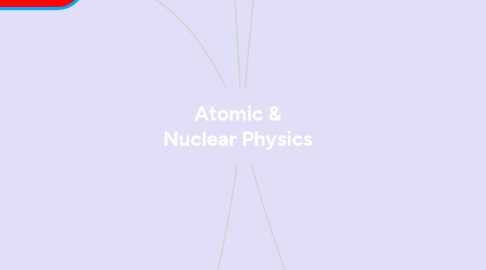
1. Half Life
1.1. Radioactive decay
1.1.1. unpredictable - a continuous but random process
1.1.2. nuclide has a constant probability of decay
1.1.3. half-life = time taken for half of total nuclei to decay
1.2. occurs in unstable, radioactive isotopes
1.3. VIDEO
2. Isotopes
2.1. different mass due to the addition or subtraction of neutrons
2.2. element remains the same and retains chemical properties
2.3. formed when an atom has the same number of protons and different number of neutrons
2.3.1. stable when left alone BUT can be forced to change in nuclear reactor or particle accelerator
2.3.1.1. radioactive isotopes = UNSTABLE
2.3.1.2. stable isotopes create a Band of Stability on a graph plotting # of protons vs # of neutrons
3. Radioactive Decay
3.1. Alpha Decay
3.1.1. Equations
3.1.1.1. The parent atom splits into the daughter product and the alpha particle
3.1.2. Alpha Particles Traits
3.1.2.1. The parent atom and the daughter product are different elements with different chemical properties
3.1.2.2. The daughter product is comprised of two protons and two neutrons (nucleus of the Helium atom)
3.1.2.3. Alpha decay is the slowest process
3.1.3. Real-Life Applications
3.2. Beta Decay
3.2.1. Negative Decay
3.2.1.1. A neutron in the nucleus becomes a proton, an electron, and an anti-neutrino
3.2.2. Positive Decay
3.2.2.1. A protein in the original nucleus decays into a neutron, a positron, and a neutrino
3.2.3. Positron Emission
3.2.3.1. A proton changes into a neutron and the excess positive charge is emitted
3.2.3.1.1. The atomic number will decrease by 1, and will keep the same mass
3.2.3.1.2. Positrons have an atomic mass of zero and an atomic number of 1
3.2.3.1.3. The emitted positron will fly through space until it encounters an electron
3.2.4. Electron Capture
3.2.4.1. An electron from a low energy orbital is “captured” by the atomic nucleus and reacts with a nuclear proton to produce a neutrino
3.2.4.1.1. This process is completed with positron emission
3.2.4.2. Produces a daughter nucleus with atomic number one less with the same mass numher
3.3. Gamma Decay
3.3.1. Often accompanies another decay mechanism; Atoms undergoing alpha or beta decay will usually emit their respected particle as well as gamma photons to stabilize
3.3.2. High-energy photons
3.3.3. The greatest penetrating power
4. Atomic Spectra
4.1. Emission Spectra
4.1.1. energy is supplied to a gas of atoms at low pressure emitting electromagnetic radiation
4.1.1.1. radiation is dispersed through a diffraction grating
4.1.1.2. spectral lines depend on energy level
4.1.1.3. Emission Spectra
4.2. Absorption Spectra
4.2.1. electrons in solids, liquids, and dense gases get excited and glow when heated
4.2.1.1. consistent band of color NOT lines
4.2.1.2. black lines of absorption spectrum = colored lines of emission spectrum
4.2.2. electron absorbs a photon whose energy is identical to the difference in energy level
4.3. Energy Levels
4.3.1. electrons are restricted to specific orbits, but they can "jump" to other orbits
4.3.1.1. electrons moving from ground state to an excited state must GAIN energy
4.3.1.1.1. absorption of light
4.3.1.2. electrons that have "jumped" to a higher orbit will return and lose energy
4.3.1.2.1. photon will be emitted
4.3.2. different orbits around a nucleus have different energy
5. Nuclear Reactions
5.1. Reactions
5.1.1. Nuclear Reactions are induced by bombarding it with an energetic paraticle
5.1.2. It results in the change in identity or characteristics of an atomic nucleus
5.1.3. There are four main types
5.1.3.1. Fission
5.1.3.2. Fusion
5.1.3.3. Nuclear Decay
5.1.3.4. Transmutation
5.2. Nuclear Equations
5.2.1. Conservation of Nucleons
5.2.1.1. During a reaction, the nucleons of the particles involved must add up to the same number on both sides of the equation
5.2.1.2. Nucleons equals protons plus neutrons
5.2.1.3. Represented by the mass number of an atom (the number on top)
5.2.2. Conservation of Charge
5.2.2.1. During a reaction, the charges of the particles involved must add up to the same number on both sides of the equation
5.2.2.2. Particles that have a charge are protons, electrons, and positrons
5.2.2.3. Represented by the atomic number of the particle (the number on the bottom)
5.3. Emitted Energy
5.3.1. Half of the total number of nuclear reactions release energy, the other half are the reversed reactions that absorb energy
5.3.2. However, almost the totality of the spontaneous reactions are the ones that release energy
5.3.2.1. Examples of this are all the variations of nuclear decay, and the released energy is sometimes referred to as decay energy
5.3.3. Emitted energy is reported in megaelectron volts (MeV), where 1 MeV is equal to 1 million electron volts
